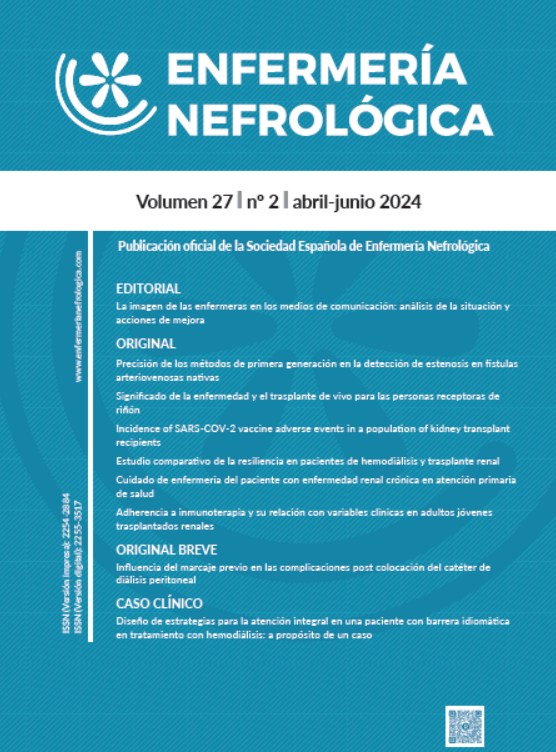Contenido del artículo principal
Resumen
Introducción: Un buen acceso peritoneal es imprescindible para la realización de la Diálisis Peritoneal, pudiendo constituir la técnica de marcaje prequirúrgico un punto clave en la aparición de complicaciones.
El objetivo de nuestro estudio fue evaluar la influencia del marcaje pre-quirúrgico en las complicaciones post-colocación del catéter de diálisis peritoneal.
Material y Método: Estudio de cohortes; incluimos a los pacientes mayores de 18 años a quienes se les colocó un catéter peritoneal en 2018 (cohorte sin marcaje) y en 2022 (cohorte con marcaje). Las variables analizadas fueron: edad, sexo, complicaciones y evolución de estas.
Realizamos un análisis multivariante mediante regresión logística, calculando la Odds Ratio (OR) y el intervalo de confianza 95% de aparición de complicaciones.
Resultados: Se analizaron 107 pacientes, 73,8 % hombres y una edad media de 65,6 ± 12,2 años.
De los 56 pacientes sin marcaje, 33 sufrieron complicaciones, frente a 18 de los 51 en la cohorte con marcaje.
La OR de complicaciones ajustad por edad y sexo del grupo marcaje frente a no marcaje fue 0,39, IC 95%:0,17-0,86.
El 38,9% de las complicaciones fueron resueltas en el grupo de marcaje frente al 24,2% en el grupo sin marcaje. (p=0,548)
Conclusiones: La técnica de marcaje previo del catéter de diálisis peritoneal se asocia a una reducción de las complicaciones postquirúrgicas en estos pacientes.
Palabras clave
Detalles del artículo
Derechos de autor 2024 Fabiola Menéndez-Servide, Mónica Fernández-Pérez, Adela Suárez-Álvarez, Jessica Blanco-Sierra, Magdalena Pasarón-Alonso, Miguel Núñez-Moral

Esta obra está bajo una licencia internacional Creative Commons Atribución-NoComercial 4.0.
Aviso de derechos de autor/a
© Los autores ceden de forma no exclusiva los derechos de explotación de los trabajos publicados y consiente en que su uso y distribución se realice con la Licencia Creative Commons Atribución - No comercial 4.0 Internacional (CC BY-NC 4.0). Puede consultar desde aquí la versión informativa y el texto legal de la licencia. Esta circunstancia ha de hacerse constar expresamente de esta forma cuando sea necesario.
Referencias
- Crabtree JH, Shrestha BM, Chow KM, Figueiredo AE, Povlsen JV, Wilkie M, Abdel-Aal A, Cullis B, Goh BL, Briggs VR, Brown EA, Dor FJ. Creating and Maintaining Optimal Peritoneal Dialysis Access in the Adult Patient: 2019 Update. Perit Dial Int [Internet]. 2019 [consultado 4 Feb 2023];39(5):414-36. Disponible en: https://doi.org/10.3747/pdi.2018.00232 DOI: https://doi.org/10.3747/pdi.2018.00232
- Crabtree JH, Hathaway PB. Patient selection and planning for image-guided peritoneal dialysis catheter placement. Seminars in Interventional Radiology. 2022;39(01):32–9. DOI: https://doi.org/10.1055/s-0041-1741078
- Rodríguez-Palomares JR, Ruiz C, Granado A, Montenegro J. El acceso peritoneal. En: Coronel, F. Guías de práctica clínica en diálisis peritoneal. Sociedad Española de Nefrología. 2005;82-107
- Aznar Artiles Y, Zaragoza Fernández C, Alfonso Porcar M, Villalba Caballero R, García Aguado R, Pérez García A. Experiencia en la colocación del catéter para diálisis peritoneal por parte de la unidad de cirugía mayor ambulatoria. Cir May Amb 2007;12:67-70.
- Díaz-Rosales JD, Herrera-Gastellum JC. Procedimientos en cirugía: Colocación percutánea del catéter de diálisis peritoneal. Arch Med (Manizales) 2016;16(2):385-2. DOI: https://doi.org/10.30554/archmed.16.2.1496.2016
- Wong LP, Liebman SE, Wakefield KA, Messing S. Training of surgeons in peritoneal dialysis catheter placement in the United States: a national survey. Clin J Am Soc Nephrol. 2010;5(8):1439-46. DOI: https://doi.org/10.2215/CJN.08751209
- Peppelenbosch A, van Kuijk WH, Bouvy ND, van der Sande FM, Tordoir JH. Peritoneal dialysis catheter placement technique and complications. NDT Plus. 2008;1(Suppl 4) DOI: https://doi.org/10.1093/ndtplus/sfn120
- Wong LP, Yamamoto KT, Reddy V, et al. Patient Education and Care for Peritoneal Dialysis Catheter Placement: A Quality Improvement Study. Perit Dial Int. 2014;34(1):12-23. DOI: https://doi.org/10.3747/pdi.2012.00190
- Khan SF, Rosner MH. Optimizing peritoneal dialysis catheter placement. Front Nephrol [Internet]. 2023 [consultado 2 Feb 2023];3. Disponible en: https://doi.org/10.3389/fneph.2023.1056574 DOI: https://doi.org/10.3389/fneph.2023.1056574
Referencias
Crabtree JH, Shrestha BM, Chow KM, Figueiredo AE, Povlsen JV, Wilkie M, Abdel-Aal A, Cullis B, Goh BL, Briggs VR, Brown EA, Dor FJ. Creating and Maintaining Optimal Peritoneal Dialysis Access in the Adult Patient: 2019 Update. Perit Dial Int [Internet]. 2019 [consultado 4 Feb 2023];39(5):414-36. Disponible en: https://doi.org/10.3747/pdi.2018.00232 DOI: https://doi.org/10.3747/pdi.2018.00232
Crabtree JH, Hathaway PB. Patient selection and planning for image-guided peritoneal dialysis catheter placement. Seminars in Interventional Radiology. 2022;39(01):32–9. DOI: https://doi.org/10.1055/s-0041-1741078
Rodríguez-Palomares JR, Ruiz C, Granado A, Montenegro J. El acceso peritoneal. En: Coronel, F. Guías de práctica clínica en diálisis peritoneal. Sociedad Española de Nefrología. 2005;82-107
Aznar Artiles Y, Zaragoza Fernández C, Alfonso Porcar M, Villalba Caballero R, García Aguado R, Pérez García A. Experiencia en la colocación del catéter para diálisis peritoneal por parte de la unidad de cirugía mayor ambulatoria. Cir May Amb 2007;12:67-70.
Díaz-Rosales JD, Herrera-Gastellum JC. Procedimientos en cirugía: Colocación percutánea del catéter de diálisis peritoneal. Arch Med (Manizales) 2016;16(2):385-2. DOI: https://doi.org/10.30554/archmed.16.2.1496.2016
Wong LP, Liebman SE, Wakefield KA, Messing S. Training of surgeons in peritoneal dialysis catheter placement in the United States: a national survey. Clin J Am Soc Nephrol. 2010;5(8):1439-46. DOI: https://doi.org/10.2215/CJN.08751209
Peppelenbosch A, van Kuijk WH, Bouvy ND, van der Sande FM, Tordoir JH. Peritoneal dialysis catheter placement technique and complications. NDT Plus. 2008;1(Suppl 4) DOI: https://doi.org/10.1093/ndtplus/sfn120
Wong LP, Yamamoto KT, Reddy V, et al. Patient Education and Care for Peritoneal Dialysis Catheter Placement: A Quality Improvement Study. Perit Dial Int. 2014;34(1):12-23. DOI: https://doi.org/10.3747/pdi.2012.00190
Khan SF, Rosner MH. Optimizing peritoneal dialysis catheter placement. Front Nephrol [Internet]. 2023 [consultado 2 Feb 2023];3. Disponible en: https://doi.org/10.3389/fneph.2023.1056574 DOI: https://doi.org/10.3389/fneph.2023.1056574




